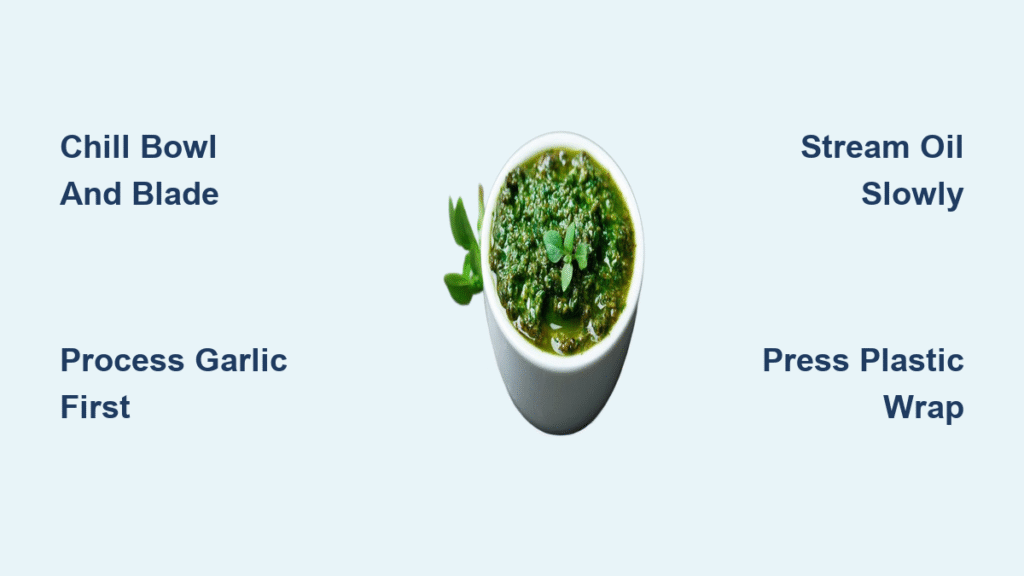There’s nothing quite like the vibrant burst of fresh basil, toasted nuts, and sharp Parmesan that defines authentic pesto—and your Cuisinart food processor transforms this labor-intensive classic into a foolproof 5-minute kitchen triumph. No more sore wrists from mortar-and-pestle grinding or gritty, store-bought jars that lack brightness. With this precise Cuisinart pesto recipe, you’ll achieve silky-smooth texture and restaurant-quality flavor that stays brilliantly green for days. Whether you’re coating twirls of spaghetti, elevating grilled chicken, or spreading it on crusty bread, your Cuisinart becomes the secret weapon for pesto that tastes like summer in every bite.
The magic lies in leveraging your machine’s engineering: the S-blade’s sharp rotation emulsifies oil perfectly while preventing oxidation that turns pesto brown. Skip the guesswork—this guide delivers exact measurements, Cuisinart-specific techniques, and troubleshooting fixes so you never waste precious basil again. You’ll learn why ingredient order matters, how to avoid grainy texture, and pro storage tricks to make one batch last weeks. Ready to unlock your food processor’s full potential? Let’s make pesto that outshines any restaurant version.
Essential Ingredients for Vibrant Cuisinart Pesto
Core Components for Authentic Flavor
Start with 2 cups packed fresh basil leaves (roughly 60 grams)—loosely fill a measuring cup, then press down gently without crushing. For nuttiness, use ⅓ cup toasted pine nuts; golden-brown edges mean they’re ready. Two medium garlic cloves, peeled, deliver that signature kick without harshness. ½ cup freshly grated Parmigiano-Reggiano (40 grams) provides salty depth—never pre-grated tubs, which contain anti-caking agents. Stream in ½ cup premium extra-virgin olive oil (120 ml) for lush emulsification, plus ¼ teaspoon fine sea salt and a pinch of black pepper. A squeeze of lemon juice (optional) locks in that electric green hue.
Custom Swaps Without Compromising Texture
Running low on pine nuts? Replace them with ¼ cup sunflower seeds for nut-free pesto that still clings perfectly to pasta. Vegan? Swap Parmesan for ¼ cup nutritional yeast—it mimics umami without dairy. For an arugula twist, substitute 1 cup of basil with baby arugula to infuse peppery complexity. Never use dried basil—it lacks volatile oils essential for fresh flavor. Stick to these ratios: too much cheese causes clumping, while excess oil breaks the emulsion.
Cuisinart Setup: Machine Prep for Flawless Results

Critical Attachments and Prep Steps
Your standard S-blade (metal chopping blade) is non-negotiable—it creates the vortex needed for even blending. Keep the feed tube pusher handy for controlled oil streaming. Before assembling, chill the bowl and blade in the freezer for 5 minutes. Cold surfaces prevent heat buildup that oxidizes basil and dulls color.
Assembly Sequence to Avoid Spills
Place the bowl on the base, insert the S-blade onto the motor shaft, and twist clockwise until it locks with a click. Snap the lid on securely, ensuring the feed tube faces forward. Test the seal by gently shaking the bowl—no wobbling means it’s locked. This step prevents leaks when streaming oil later. Never skip drying components: residual water from washing makes pesto watery.
Perfect Cuisinart Pesto Processing Steps
Why Ingredient Order Determines Texture
First, process garlic alone: With the machine running, drop cloves through the feed tube. Mince for exactly 5 seconds—any longer and heat makes it bitter. Next, add pine nuts and pulse 3–4 times until coarsely chopped (think coarse sand). Over-pulsing creates nut butter that won’t emulsify. Then, add basil loosely packed into the bowl, pressing down lightly with the pusher. Pulse 5 times to break leaves without shredding. Finally, sprinkle in cheese, salt, and pepper—adding them late prevents clumping.
Emulsification Technique for Silky Results
With the processor running, slowly stream olive oil through the feed tube in a pencil-thin trickle (15–20 seconds total). Too fast? Oil pools and won’t incorporate. Stop when the pesto coats the bowl’s sides like thick paint—never over-process. Heat from extended blending oxidizes basil, turning sauce brown and flat. Scrape down sides once with a rubber spatula, then pulse twice to integrate.
Fine-Tuning Flavor Before Serving
Taste immediately: add salt in ⅛-teaspoon increments if needed, or ½ teaspoon lemon juice to brighten dull flavors. If too thick, drizzle in 1 teaspoon warm water (not extra oil—it breaks emulsion). For nuttier depth, pulse in 1 extra tablespoon toasted pine nuts. Remember: pesto mellows after 10 minutes, so under-salt slightly.
Troubleshooting Your Cuisinart Pesto Recipe

Fixing Bitter or Dark Green Pesto
Cause: Old basil or over-processing generates heat that oxidizes chlorophyll. Solution: Blanch leaves first—dip in boiling water for 10 seconds, then shock in ice water. Pat completely dry before processing. Never use bruised or yellowing leaves.
Eliminating Grainy Texture
Cause: Pine nuts not ground finely enough before adding basil. Solution: Process nuts alone for 10 seconds until paste-like, scraping sides once. If already grainy, reprocess with 1 teaspoon oil in 3-second bursts.
Rescuing Watery Sauce
Cause: Wet basil leaves introduce excess moisture. Solution: Spin dry in a salad spinner, then roll leaves in a clean kitchen towel to absorb water. Never wash basil right before processing—do it hours ahead and air-dry.
Storage Secrets for Longer-Lasting Freshness
Refrigeration Methods That Preserve Color
Transfer pesto to an airtight glass jar, pressing plastic wrap directly onto the surface to block air exposure. Top with ½ teaspoon olive oil as a barrier. Properly sealed, it stays vibrant for 5 days—not the 2–3 days typical of store-bought. Avoid metal containers; they accelerate browning.
Freezing for Year-Round Flavor
Spoon into ice cube trays, freeze solid (2 hours), then pop cubes into a freezer bag. Squeeze out air before sealing. Thaw overnight in the fridge, or drop frozen cubes directly into hot pasta—the residual heat melts them perfectly. Keeps 6 months without flavor loss.
Reviving Separated Leftovers
If oil pools on top, whisk in 1 teaspoon warm pasta water—its starch re-emulsifies the sauce. Never microwave; heat destroys freshness. For thickened pesto, stir in ½ teaspoon lemon juice while whisking.
Creative Uses Beyond Pasta Tossing
Perfect Pasta Ratios and Techniques
Use ¼ cup pesto per 8 ounces cooked pasta, reserving 2–3 tablespoons starchy pasta water. Toss over low heat 1 minute—never boil, which dulls flavor. For cold pasta salads, double the pesto to ½ cup since it absorbs less.
Unexpected Flavor Boosters
- Sandwich spread: Layer on turkey paninis with roasted red peppers
- Dip base: Stir 2 tablespoons into Greek yogurt for veggie crudités
- Soup finisher: Swirl over tomato bisque just before serving
- Pizza secret: Brush on dough instead of tomato sauce, then top with mozzarella
Post-Processing Cleanup for Stain-Free Machines
Immediate Rinse Protocol
Unplug the unit, then disassemble the bowl, lid, and blade. Rinse all parts under warm running water immediately—dried-on basil and pine nut oils become stubborn. Use a soft sponge; never abrasive pads that scratch plastic. Dry thoroughly with a microfiber cloth to prevent garlic odor retention.
Removing Stubborn Green Residue
Soak stained parts in equal parts white vinegar and water for 10 minutes. Scrub gently with a baking soda paste (1 tablespoon soda + 1 teaspoon water). For the S-blade, hand-wash only—dishwashers warp the metal. Never submerge the motor base.
Mastering this Cuisinart pesto recipe means never settling for bland, jarred versions again. The precision of your food processor—combined with cold prep, ingredient sequencing, and smart storage—guarantees vibrant, restaurant-quality results every time. Now that you’ve nailed the classic, experiment freely: try parsley-tarragon blends, swap walnuts for pine nuts, or fold in roasted garlic for depth. Each batch proves how a humble countertop tool can transform six simple ingredients into culinary magic. Your next pesto moment is just five minutes away—grab that Cuisinart and let the basil fly.





